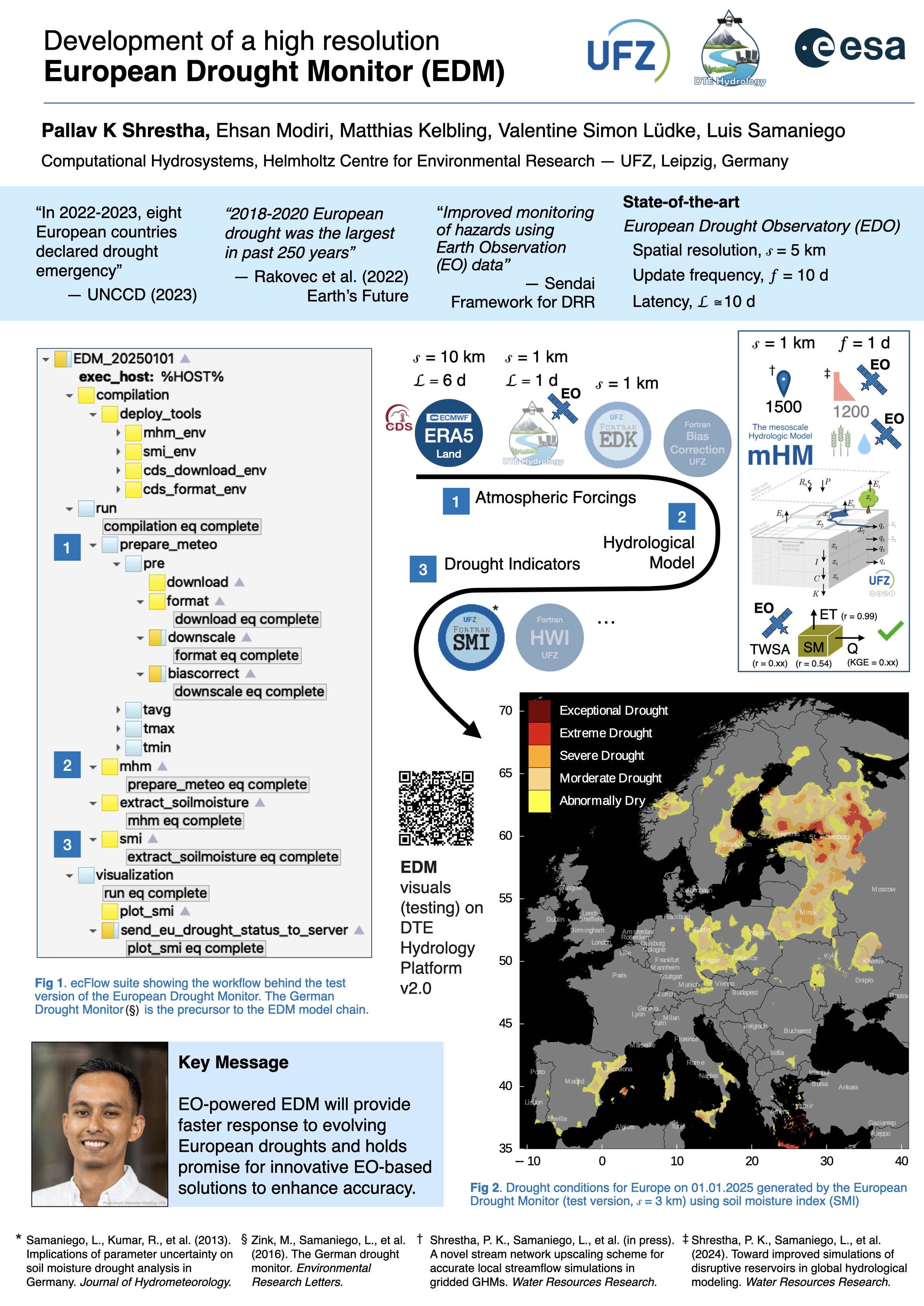Digital Twin Earth (DTE) Hydrology Next
Use Case "Drought Monitoring"
Droughts are the costliest of natural disasters in Europe contributing to loss of 621 million euros per drought event (Zink et al., 2016). In 2022-2023, eight countries from Europe declared drought emergency (UNCCD, 2023). Besides cutting crop yields (e.g., Germany’s 2018 drought: 16 % loss), droughts fuel wildfires and heatwaves. The ability to monitor the occurrence of droughts at high resolution (1 km) and in a timely manner (near real time) is one of the great challenges in European hydro-meteorological sciences.
We respond with the European Drought Monitor (EDM), which is based on the precursor system of the German Drought Monitor (Zink et al., 2016; Boeing et al., 2022) and previous scientific demonstrations and analyses at European level (Thober et al., 2015; Samaniego et al., 2017; Thober et al., 2018; Samaniego et al., 2018; Wanders et al., 2019; Samaniego et al., 2019; Rakovec et al., 2022).
The EDM is an end-to-end model chain that produces the European drought status, currently using SMI with plans to extend to multiple indices. EDM is evolving, and will be soon empowered by EO products to provide faster response (1 km, near real-time, daily updates) to evolving European droughts and flash droughts. Furthermore, EO-powered EDM would ensure enhanced accuracy with EO verified model simulations including soil moisture, evapotranspiration, total water storage anomaly, reservoir levels, reservoir extents, irrigation water use, among others.
EDM is currently in testing phase and the following is a sample display.
European Drought Monitor (EDM)
Take me to the interactive EDM in the DTE Hydrology Platform.

Operationalization Status of EDM
The EDM is currently in testing phase. The pilot model chain is implemented with on going addition of subsequent complexities. Please find the updated status below:
Incorporated tasks (updated daily):
- ERA5 land download from the CDS with 6 days latency
- ERA5 land downscaling to 3 km using conservative remapping and formatting to mHM standard
- Single domain mHM setup with European streamflow observation stations from the GRDC database (n = 1616)
- mHM run at 3 km using downscaled ERA5 land (routing resolution currently at 12 km, using SCC)
- SMI run from soil moisture (averaged across layers) at 3 km
- Graphics generation from SMI output
Pending tasks:
- Implementation of EDK, instead of conservative remapping, for downscaling of ERA5 land to 1 km
- Retrieval of 1 km EO-based forcing from project partners to curb the latency of ERA5 land for near real-time monitoring
- Bias correction of both ERA5 land and EO-based forcings using EMO-1, at 1 km
- mHM setup: Incorporate European dams from the GRanD database (n ≅ 1200)
- mHM development: A new irrigation module
- mHM setup: Ingest EO-based demand, source, sink information on irrigation water use from project partners
- mHM run at 1 km instead of 3 km
- HWI development: A new fortran software to calculate HWI
- HWI run from temperature forcings
- Graphics generation from HWI output
- Additional drought indicators ...
Premise
(Excerpt from Digital Twin Earth (DTE) Hydrology Next project webpage)
Previous DTE Hydrology evolution projects (see Brocca et al. (2024)) demonstrated the potential to advance towards an end-to-end reconstruction of the hydrological cycle at high resolution in space and time by an effective combination of state-of-the-art EO data, in situ observations, advanced hydrological and hydraulic modelling, AI and advanced digital platform capabilities.
DTE Hydrology Next project will provide further advances in that respect by implementing use cases for flood and landslide prediction, drought monitoring and water resources management, and by developing a cloud-based infrastructure for the visualization and the full interaction with the simulations and the results of the Use Cases.
UFZ is responsible for the project use case on drought monitoring, including flash drought, for Europe.
Development of a high resolution European Drought Monitor
Shrestha PK, Modiri E, and Samaniego L.
ESA Living Planet Symposium
Vienna 2025
Droughts are the costliest of natural disasters in Europe contributing to loss of 621 million euros per drought event. In 2022-2023, globally 23 countries declared drought emergency including eight from Europe. Besides cutting crop yields (e.g., Germany’s 2018 drought: 16 % loss), droughts fuel wildfires and heatwaves. The ability to monitor, model and forecast and/or predict the occurrence of droughts seamlessly, along several scales in space (1 km to 25 km) and time (weeks to seasons to decades), constitutes one of the great challenges in European hydro-meteorological sciences.
We respond with the European Drought Monitor (EDM) with high resolution (up to 1 km) and latency of few days. The EDM is based on the precursor system of the German Drought Monitor and previous scientific demonstrations and analyses at European level.
The system constitutes of a single, continental modeling domain of the Europe employing the mesoscale hydrological model (mHM, https://mhm-ufz.org) incorporating major European reservoirs and a new irrigation module. Advanced earth observation (EO) products are used in conjunction with downscaled 1 km ERA5-land, both bias corrected using EMO-1, to cut the latency of meteorological forcings for near-real time initialization of the hydrological model. Furthermore, EOs are used in the estimation of irrigation demand and command area as well as in validation of model output including evaporation (CGLS at 1 km), soil moisture (ESA CCI SM v08.1 at 25 km), snow water equivalent (SMOS at 50 km), and total water storage (GRACE-FO at 100 km). Once the reliability of the system is demonstrated, the EDM generates drought indicators such as soil moisture index (SMI) and heat wave index (HWI) as proxies to impact on irrigation for the end-users. For reproducibility, the EDM backend is powered by ecFlow, the workflow management system developed by ECMWF.
The comprehensive EO augmentation demonstrated in the EDM reverberates with the Sendai Framework for Disaster Risk Reduction, which, among others, calls for improved monitoring of hazards using EO data. With the EO integration, we expect the operationalized EDM to generate `timely` warning and help us to decipher novel solutions to the challenge of the evolving European droughts.

Use Case Lead Institution:

Collaborating Institutions:

Contact Persons:

Funding Agency:

Coordinating Institution:



